After a few miserably rainy days, we were thrilled that Saturday dawned bright and sunny for our final open day on Tayne Field.
There was lots going on, with stalls and displays of finds, zooarchaeology, environmental archaeology, and explanations of scientific techniques amongst the replica costumes and weapons, Saxon re-enactments and children’s activities!
We tried to represent and explain most of what goes on on the dig, and these technical stalls of information and objects proved to be really popular with our visitors. This season has been
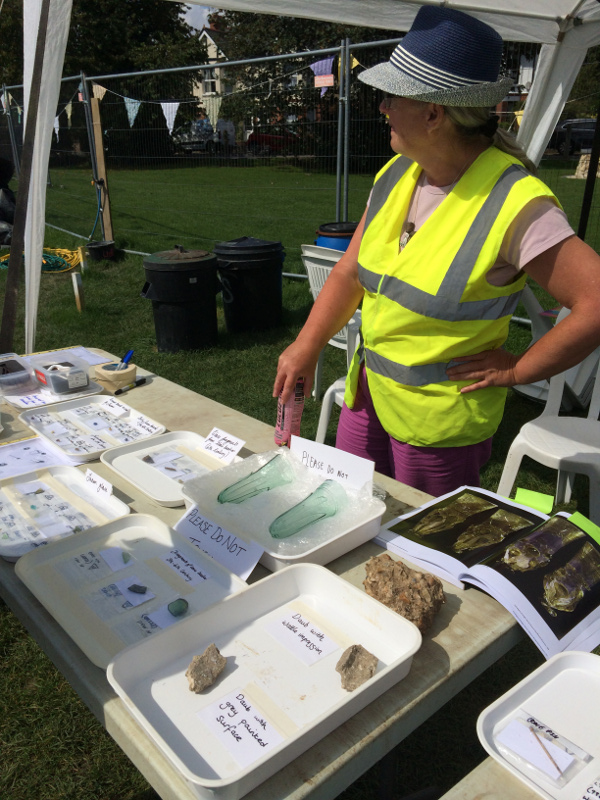
Helen shows off our wonderful finds from the excavations so far, with images and replicas to help put fragments in context

Zoe and Pip on hand to explain the kinds of animals we find at Lyminge, and what their bones can tell us
incredibly productive so far, so we had a whole range of artefacts, animal bone and botanical remains to present, even with a couple of weeks of the dig left.
The childrens activities were as popular as ever, with the chance for kids to try their hand at digging and identifying finds in the ‘Little Dig’ pits, as well as being able to design their own Saxon brooch, with refreshments on hand!
Geoff Halliwell returned this year to talk about flint knapping, and as I toured the open day I heard many people saying how interesting they found his explanations. We have collected thousands of struck and worked flints from our trenches on Tayne Field, so it was great to have this element of the dig represented on the open day.
Site tours went on all day, with the crowds getting bigger and bigger with each one. We estimated that at the end of the day, over 400 people had come through our gates, matching last year’s attendance.
Ever popular were the Saxon re-enactments by the Centingas early Saxon group, with the clashing of swords on wooden shields heard across site all afternoon – but also on show were the quieter but just as significant explanations of daily life shown through dress and displays of craft and Saxon foods. Family life was represented by an extremely good Saxon baby all snuggly in her basket!
We were really pleased to have Jennifer Jackson on hand for the open day. Jennifer is the Finds Liason Officer for the Portable Antiquities Scheme in Kent. If you find something in your garden or while out and about, you can take your finds to to be recorded and identified by your local FLO, and usually you won’t have to give up your find unless it qualifies under the Treasure Act.
This gives us a national record of artefacts that are found by individuals, often metal-detected, and helps archaeologists to collect data about our heritage that might otherwise go unknown. Whenever an assessment is done for planning permission, the PAS database is checked for local finds, and this influences whether an archaeological survey is required before construction.
Jennifer brought along a few finds that were reported to her locally, found in Lyminge, but not excavated by us. They are in poor condition, but are interesting items
nonetheless, and items that we do not have in our settlement excavation being commonly found in Saxon cemeteries. The pieces of a shield boss, a knife and an iron fitting for a shield were found locally, reported to Jennifer and left with her by the finder.
But what of the archaeology in our trenches? Digging continued on the open day, as it has since the last blog post! We have started to excavate a series of post holes in Trench 1 to the west of the midden area that also cut across the western edge of the Bronze Age ring ditch.
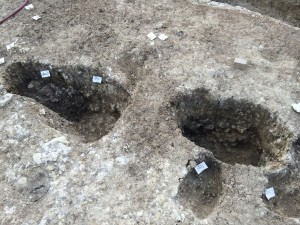
Doorway post holes, significantly deeper than the other post holes associated with this timber structure
The post holes are aligned east-west and clearly form part of a rectangular timber structure. Only a portion of these have been excavated so far, so it is difficult to make out the rectangular arrangement of the postholes from photographs, but we have already identified the door posts to the building, interestingly containing metalworking slag.
It’s really exciting to see a whole post-hole built structure in our trenches. While we have fabulous wall trench architecture in the form of several timber halls, these structures are very much ceremonial, for feasting and entertaining, while we have much less evidence for ancilliary buildings and domestic dwellings. We don’t yet know the exact function of this smaller building, but it is great to see a range of building types at Lyminge, to go with our feasting halls and sunken-featured buildings – even if this post-built structure isn’t of the same phase as the halls.
Intrepreting a function for this post built building might be easier now that we have started to get a handle on the function of the midden area, known to us as the ‘blob’. For several weeks we have been digging into layers of rubbish that date to the early Saxon period in a very large area in the south-east portion of Trench 1. While we have been clear that the area was filled with midden material and lots of metal working debris, what we didn’t know is why there was a hollowed out area that became filled with rubbish to begin with – digging out large areas simply to fill them with rubbish isn’t something known in Anglo-Saxon settlements.
In the last couple of days we have come down onto a feature that is certainly a hearth (perhaps in two phases), and we have been finding lots of smelting and smithing slag as well as pieces of furnace and hearth lining throughout the midden material.
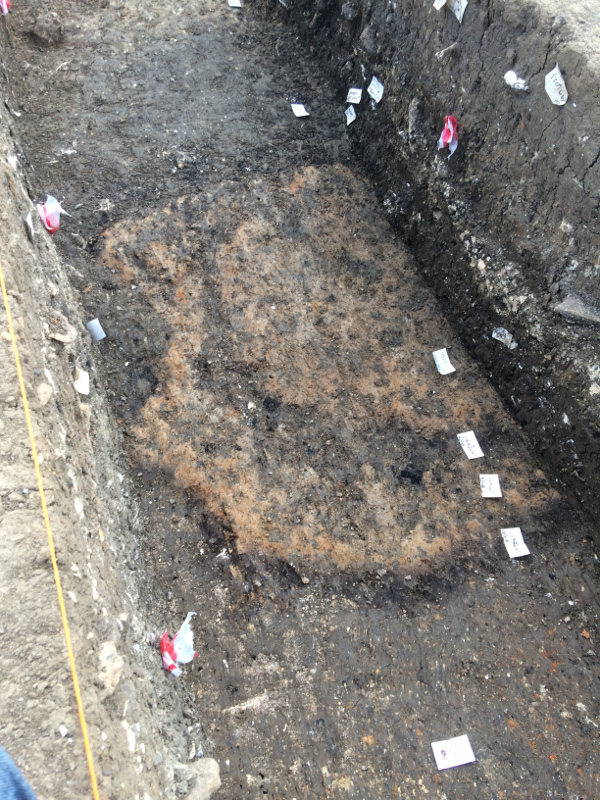
An in situ hearth probably associated with metal working, discovered in the east-west slot excavated through the midden area
It seems more and more clear that we have a very early example of an industrial area dug out for metalworking. There is a parallel for a metalworking hollow from the excavations undertaken in the 1970s at Ramsbury, in Wiltshire, although the Ramsbury example dates to the 8th and 9th centuries AD, and the evidence at Lyminge points to a much earlier date with the rubbish layers above the hearth containing material dating to the 6th century.
This potential early date is incredibly exciting, especially as nothing like this area is known from the Kent region. We are stepping up the excavation process using swing sieves to help speed everything up in order to gain as much information as possible in the time we have left.
Further confirmation of this site as a metalworking area came yesterday with a fragment of a clay mould found by Keith Parfitt. It looks like molten metal (perhaps copper alloy) would have been poured in and moulded into something with a round shape to it – still visible here. Scientific analysis of the mould will tell us what metal was poured in.
The focus now in the last couple of weeks is to firmly establish what lies at the bottom of the metalworking hollow, to complete the timber hall areas that I’ve talked about in previous blog posts, and to excavate all the post holes that form the footprint of the post built structure in Trench 1. Trench 2 is coming on extremely well, with internal partitions, large post holes and possible end walls being revealed within the footprint of the feasting hall and its multiple phases.
We have lots and lots of exciting work to do in the next two weeks with all of these highly significant features. I’m sure I’ll be bringing more news very soon, particularly as we reach the lower layers within the metal working area below the midden, and start to work out how this area functioned in the early Anglo-Saxon period.
I’ll leave you with some images from the past few days that I wasn’t able to put into this weeks blog post – so much to show you and so little room!



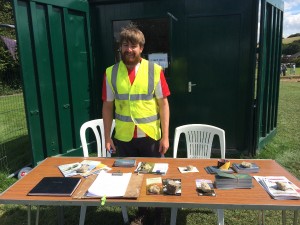
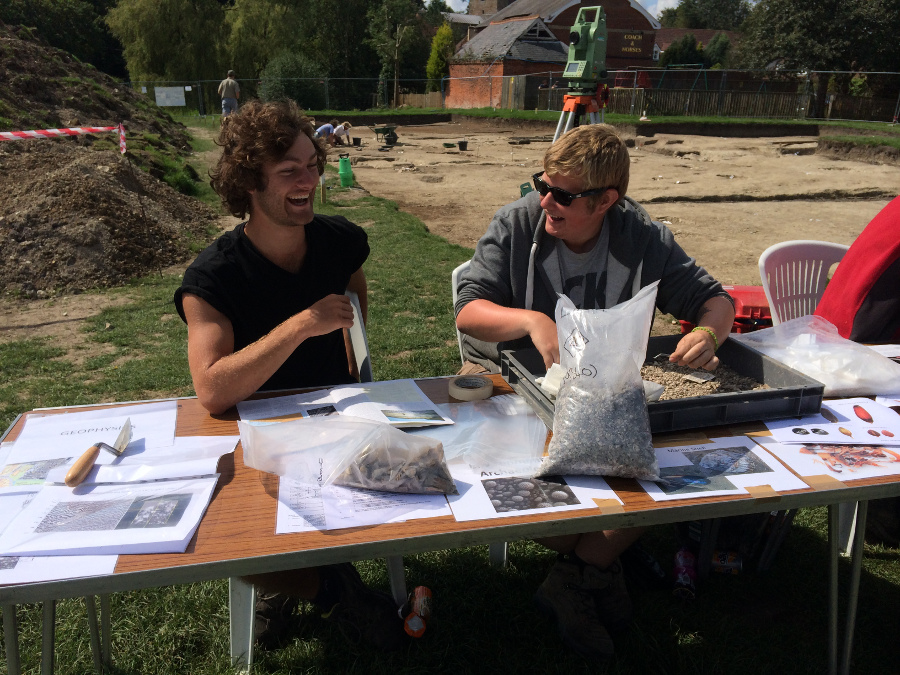










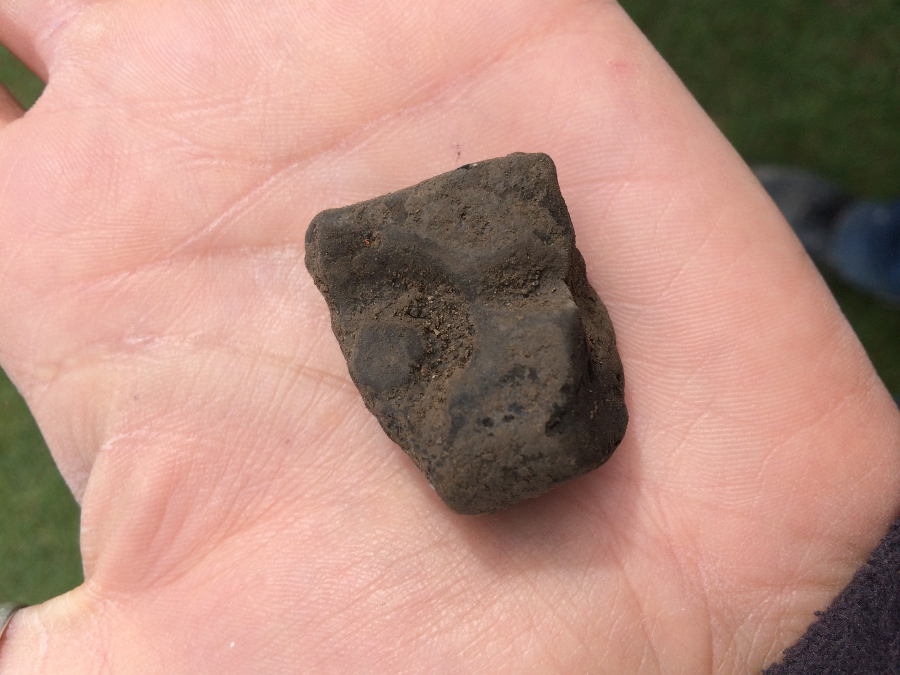

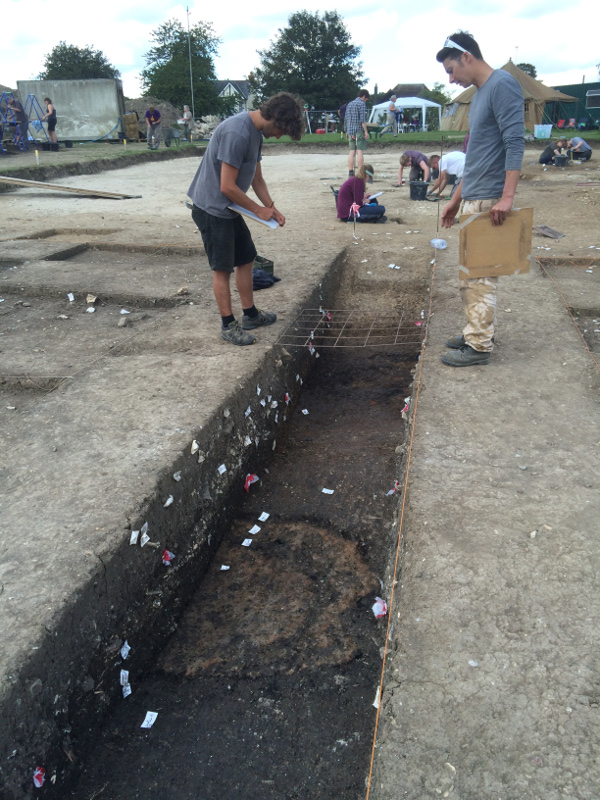
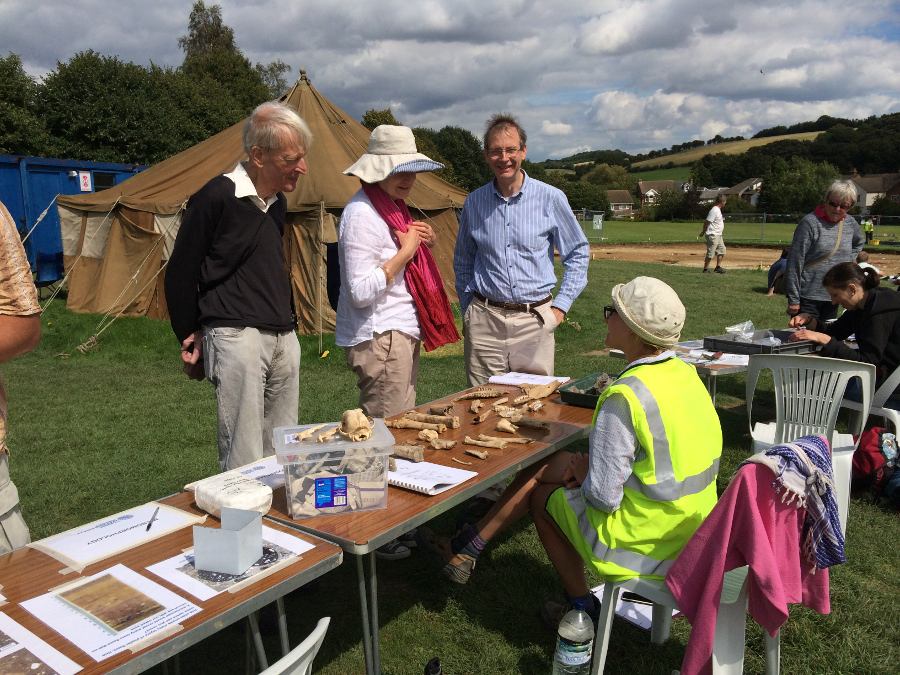

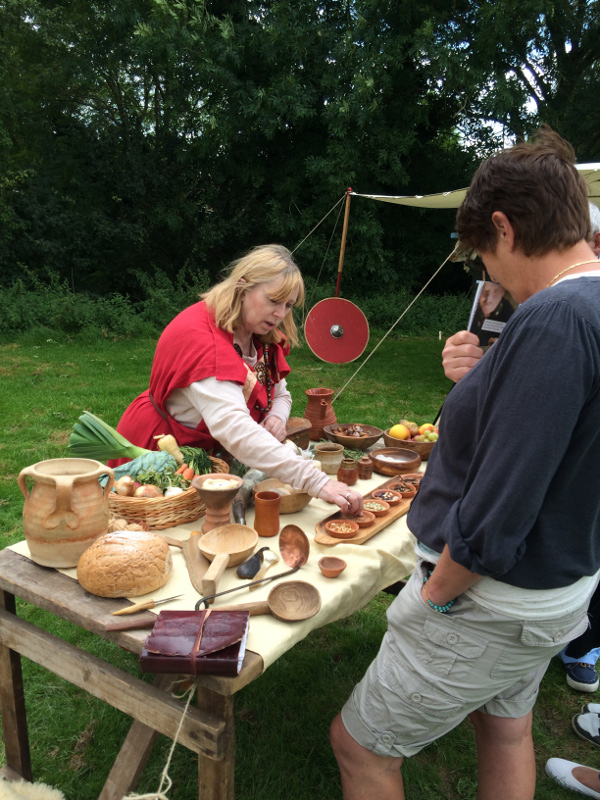
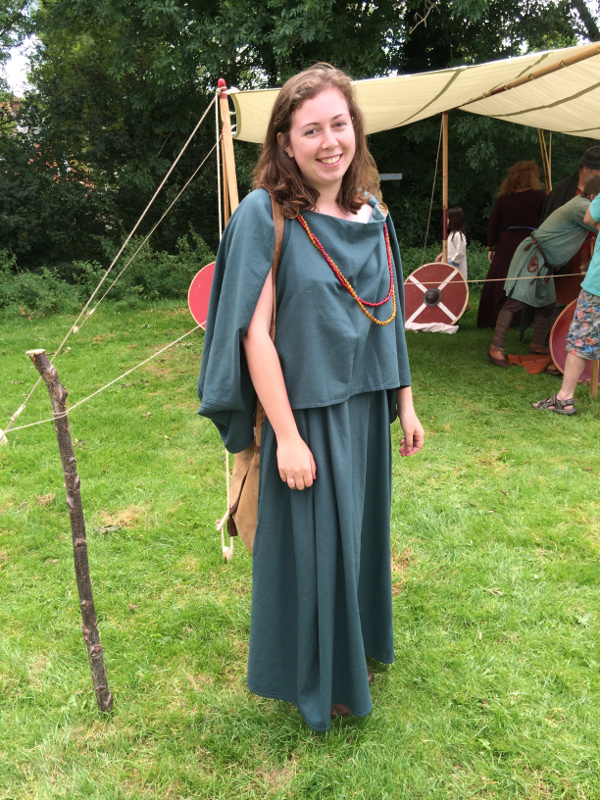
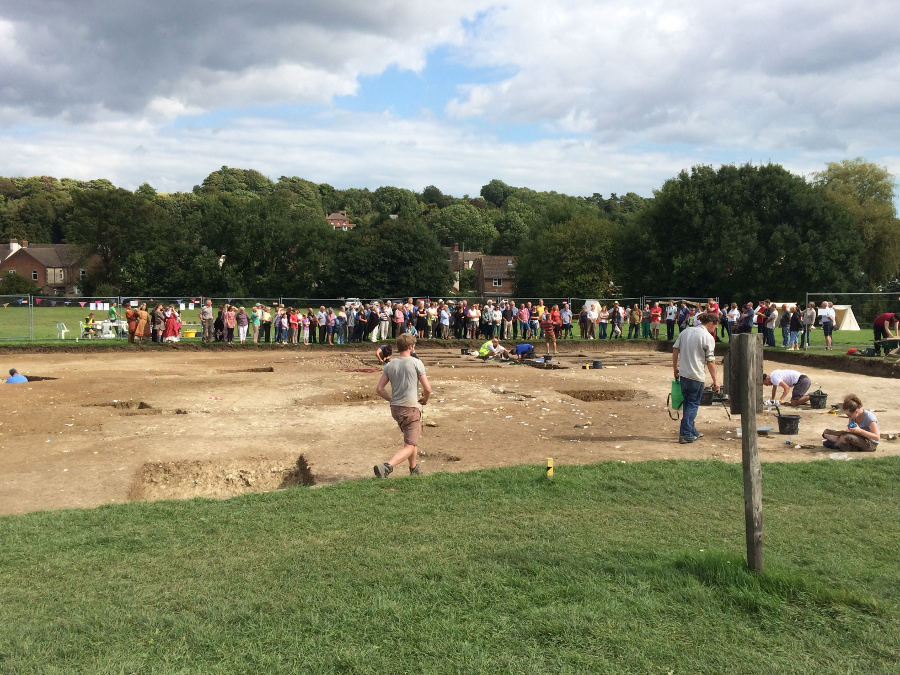
So glad the open day was a such a success. The finds and information coming out of this year’s dig are fascinating and I would have loved to be part of it but managed to fracture my arm on the way to Tayne field 10 days ago. Big thank you to Helen and Alexandra for looking after me so well.
Lynda I’m so sorry to hear it was broken! Glad we could help you get to see the professionals and I hope it gets better really soon.
Hi Alexandra, When you live about 200 miles from Lyminge it’s a real treat to be able to follow the excavations and findings on your regular blog. I find it quite exciting and wish to thank you for the expert, clear presentation of current findings. Your text is so readable to a non professional who won’t see 80 again.
Thank you very much. John T.
You have no idea how giddy I am with excitement over the hearth beneath the midden! Iron smelting, I assume?
Good luck this week 🙂